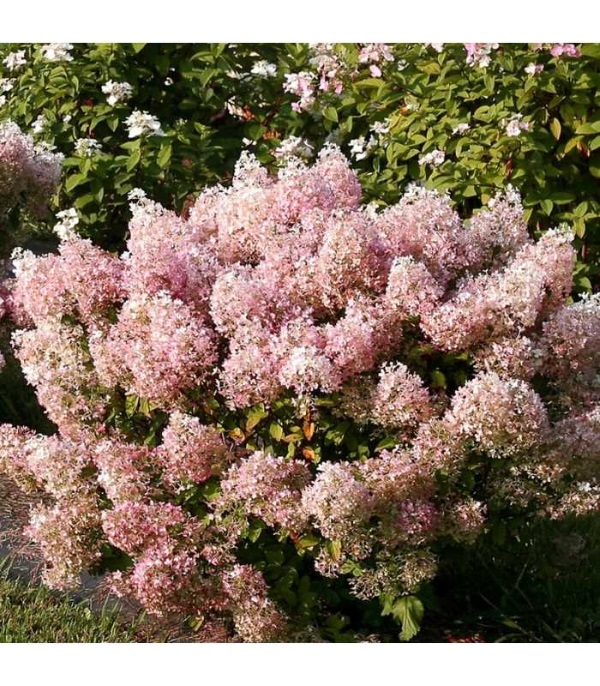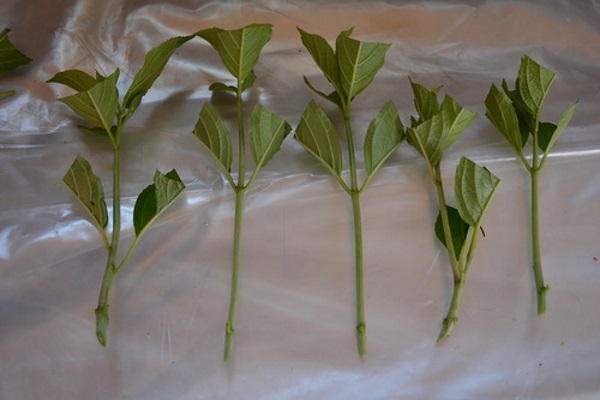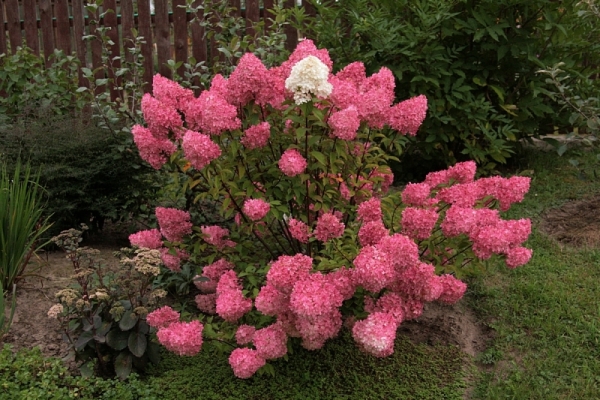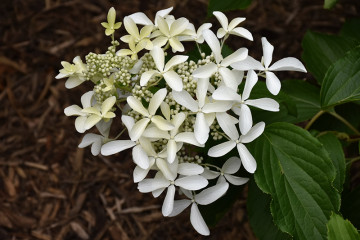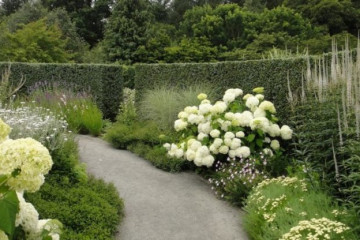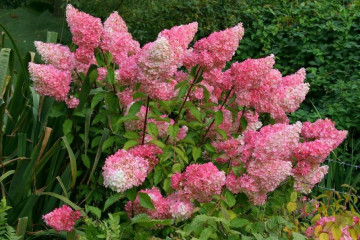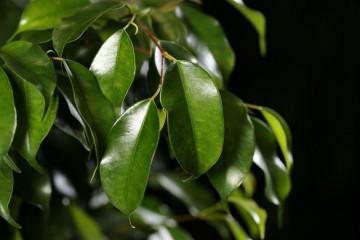Hydrangea Bobo - a dwarf variety of panicle winter-hardy hydrangea
Content:
Hydrangea Bobo is the smallest shrub of the paniculate genus, reaches only 60-70 cm in height, forms compact bushes, resembling a sphere in shape. Bushes grow quickly, so hydrangea blooms are extremely abundant.
Hydrangea origin
The Bobo panicle hydrangea, which appeared in Europe in the 18th century, has earned the recognition of gardeners. Delicate bushes brought from Japan are appreciated for the opportunity to admire the magnificent balls of inflorescences. Breeders from different countries have helped the unique shrub fill the gardens of Europe.
The hydrangea Bobo variety (Hydrangea paniculata Bobo) was bred by scientists from Belgium, having received an award at the Florall exhibition for the best new frost-resistant variety. As a result of many years of breeding work, this species now has winter hardiness and a variety of colors.
Description of the flower hydrangea Bobo
The plant is a spherical shrub, the shoots are red-brown, the leaves are coarse, oval, green (in autumn they turn yellow), with denticles along the edges. The flowering period is July-September.
Hydrangea Bobo variety blooms early, already in early July, and then becomes a lush bouquet of medium-sized white inflorescences, which are closely adjacent to each other. At the end of summer, the flowers turn slightly pink, but the Bobo hydrangea retains its attractiveness until late autumn. Despite their small size, they surprise with abundant, phenomenal flowering. They create the effect of compact spherical panicles, similar to pyramids.
Wonderful white flowers are attached to tough, strong shoots, as they wilt, they acquire delicate pink shades. Fruit flowers are small, crumble early, fruitless - much larger. Hydrangea paniculata Bobo attracts bees, because it is a honey plant.
Transplant after purchase in open ground
Perennial appearance and development depend on the season. If you buy plants in the early spring period (March-April), you need to understand that many of them are in the sleep phase. An accurate description of Bobo hydrangea cuttings will help you choose the right planting material. Cuttings usually do not yet have leaves and shoots or are just beginning to develop. Some grow rapidly since March, despite the cold, others still need warm nights, typical of spring and early summer.
What is needed for landing
For lush flowering, you need fertile humus and constantly moist soil, enriched during planting. Pelleted manure or compost should be added annually in the fall. The plant loves mulching with pine bark.
The bush should not be placed near moisture-loving trees, otherwise they will take all the water for themselves, and Bobo will suffer. The location should be semi-shady or sunny, but not very hot. It tolerates not very long dryings, but definitely prefers constantly moist soil.
How to choose the best place
Landing is best done in partial shade.The soil should be fertile, slightly acidic, with humus. In sunnier areas, conifers in silver needles such as the Baby Blue cypress bear pi, Glacier juniper, which will gracefully nestle at the foot of Bobo, would be good society.
During the growth period, it is worth providing the bush with a large amount of water, as well as nutrients.
Step-by-step planting process
Bobo panicle hydrangea is planted in autumn and spring. Its roots are not very deep, but branched, so you need to place the plants no closer than one meter from each other.
- Before planting a hydrangea, it is necessary to dig a hole twice as large as the shape of its root system, fill it with ready-made soil for hydrangeas or with a self-compiled mixture - half and half of fertile soil and sour peat. To increase soil fertility, it is worth adding mature compost.
- Plant a plant with a lump at the same depth at which it grew in a pot or nursery.
- Tamp it tightly so that there are no gaps left through which the roots can dry out and water.
In addition, the plant needs to be loosened at least once every two to three months, because it loves "fluffy" soil.
Reproduction of Bobo hydrangea
Bobo dwarf hydrangea will best tolerate the breeding procedure in spring or autumn with the help of layering, cuttings and dividing the bush.
The easiest way is division. A bush is dug up and divided with a knife or a sharp shovel into parts with shoots. You can not completely take the bush, but only dig it in on one side, dividing it into parts. Transplant one, and leave the second in its place. Having planted new young bushes, be sure to water well, and then add root-forming stimulants for better strengthening and growth.
Propagation by cuttings
This is a method of vegetative propagation of plants: a part is separated from the mother bush, which is called a cuttings. Own-rooted plants are obtained that retain the properties of a given species and variety. If direct sunlight falls on the cuttings, it is recommended to artificially shade by building some kind of cover over them.
You can also cuttings in winter, for example, on a veranda or in another cool place.
In June, spring cuttings are cut from young shoots with a heel (part of last year's growth). And the July cuttings can be cut from the non-lignified part of the branches. It is necessary to use the upper parts of the shoots with two internodes, the leaf plates are cut inward to reduce moisture loss.
As a primer, use a mixture of peat and sand in a ratio of 2: 1 or soil with leaves, on which a layer of sand is poured.
Cuttings take root quite well, the survival rate is high. In colder regions, rooted cuttings are grown in greenhouses, basements or pots, where they are easier to care for before they land permanently in open ground.
Bobo hydrangea care
Maintenance includes regular watering, loosening the soil, top dressing, pruning and weeding. Hydrangeas are aquatic flowers and are sensitive to lack of water. In the spring and before flowering, it is good to nourish with mineral fertilizers.
Pruning
After flowering, dry flowers retain their decorative qualities until spring, so they should not be cut. Pruning is carried out in early spring before the beginning of the growing season every year: dried inflorescences are removed before the first pair of strong buds. Pruning too thoroughly is not required as it may result in poor flowering. If the bush is too dense, it is enough to remove the old, weak and curved branches with the root.
Young, newly planted shrubs do not require heavy pruning. It is necessary to inspect the bush and selectively remove damaged and weak branches. We cut all last year's shoots strongly at the same height: 1-2 pairs of well-formed and healthy eyes.
This procedure is very simple for novice gardeners, so there is no need to be afraid of it, because, even if done incorrectly, it will not deprive you of all flowers this season. And the lack of cutting will make the plant overgrown with small flowers. The procedure should be performed on a clear, frost-free day with clean sharpened instruments.
It is recommended to lubricate lignified shoots with a larger diameter (more than 1 cm) with a horticultural ointment with a fungicide to limit the risk of infection. Trim all shoots low.
Watering mode
All types of hydrangeas require regular watering, especially on dry sandy soils and in the scorching sun. There should always be a lot of moisture, it is advisable to cover the soil with roots with a layer of mulch. This is the main concern for the hydrangea. It is best to water it early in the morning or late in the evening, when there is no scalding sun, and not cold water. But you can sometimes set up irrigation throughout the day.
Even a small water deficit causes wilting of both leaves and inflorescences. During the period of growth and flowering, hydrangea is watered daily, the soil should be constantly moist, but not flooded. Remember not to pour water on the flowers when watering.
Top dressing
Hydrangeas need soil that is permeable to air and retains moisture well.
The most common feeding methods are:
- The addition of peat and humus - to improve the properties of the soil.
- Potash fertilizers - to increase frost resistance and good flowering.
- Iron and aluminum - to acidify the soil and produce blue flowers as a result.
It is enough to feed it 2 times a year: in the spring - organic fertilizer, in the bud formation phase - a liquid mixture of urea, potassium and superphosphate. You can also purchase liquid fertilizers, which you can water the plants every 7-10 days.
Features of care during flowering
If the culture has thin shoots, then you need to tie them up, especially when mass flowering begins, otherwise the branches may break.
Each owner of a chameleon bush is able to control the color of its flowers, you just need to change the acidity of the soil. To obtain a reddish-pink scale, a more alkaline earth should be maintained, acidic soil turns flowers into blue-violet.
Features of care during the rest period
The plant rests from October to March. Therefore, if you properly prepare it for winter, no more special care is required.
Preparation for winter includes the following stages:
- In the month of September, stop watering.
- Do not cover for the winter. Bobo hydrangeas winter well in our climate, and there is no need to cover them for the winter, except in the northern regions. There you need to spud the bush and cover it with a layer of peat and fallen leaves.
- The lower leaves should be removed when the first frost hits.
- After the leaves have fallen off, the bush should be tied up in such a way that a cone is formed.
The range of possibilities for using Bobo in design is very wide. It looks good in small gardens, is planted singly or in groups, it can be a decoration for large plantations on terraces and balconies.
Landscapers often use flowers in conjunction with many perennials. At this time, rudbeckia, Kolosov's liatra, sage, lavender, sunflowers, echinacea, delphinium, strong aconite, phlox, lilies bloom. They are recommended to be planted in larger groups next to the hydrangea.
Although the plant is considered unpretentious, it still dies in severe frosts of -35-45 ° C. But even in these difficult climatic conditions of Siberia and the Urals, they found a way to breed panicle hydrangeas of dwarf winter-hardy varieties. However, you should buy seeds or seedlings grown in these regions. Bobo is locally tested and feels great here.

